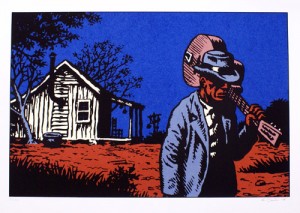TheGuitarLesson.com
This post appeared first at Blues Guitar Rhythm Styles on TheGuitarLesson.com, thanks for reading.
There are several types of blues guitar rhythm styles to play around with when you start experimenting with the blues. Some of them will be more characteristic of what you already know to be the blues, and in others, you will hear similarities with other genres. Here are you basic blues rhythm styles:

Feel the blues…
- Shuffle
- Straight-four
- 12/8
- Two-beat
- 16 feel
All of these blues rhythm styles provide a distinct feel to the music you are playing. Let’s have a look at these rhythm patterns in detail, with examples from some popular blues songs.
The Shuffle
The shuffle is probably the most characteristic blues guitar feel. It utilizes a triplet based rhythmic division, where the 2 eighth notes are played in such a way, where the first eight note is held longer than the second eighth note. To be precise, the first eighth note is held for the duration of the first 2 notes of a triplet, and the second eighth note is held for the duration of the third note in the triplet.
This creates the typical lopsided blues feel with the flow of eighth notes, as demonstrated by Robert Johnson:
Straight-Four
The straight four is a rhythmic style where your eighth notes are spaced evenly in 4/4 time, just like in most normal non-blues musical genres. This style is differentiated in blues, since it is rather uncommon and different from the usual shuffle pattern found in many blues songs.
Listen to BB play a straight-four rhythm song:
12/8
The 12/8 style is found often in slow blues. The notation 12/8 means that there are 12 eighth notes to the bar, where each note gets 1 beat. It sounds complicated, but it’s not. You can actually think about this style like 4/4 time with eighth note triplets on every beat.
Here is an example of slow 12/8 blues in a backing track:
Two-beat
Blues guitarists actually borrowed the two-beat rhythm pattern (also known as cut time or cut shuffle) from Dixieland and Jazz. Two-beat blues is very lively unlike slower blues songs, and have a characteristic base note-chord pattern to to them, where you play the base note than the rest of the chord.
Listen to Maddy Waters’ mojo in two-beat style:
16 feel
The 16 refers to a 16th note subdivision which adds a funky sound to the usually slower paced 16 feel songs.
The rhythm found in blues tunes is various, however, the shuffle is the most dominant among them all.
If you are thinking about learning to play blues guitar, you’ll be able to learn the above rhythm patterns, along with everything else to play like BB with these blues guitar lessons.
TheGuitarLesson.com is your source for beginner guitar lessons.
Read More
This article is from an external source and may contain external links not controlled by Empeda Music.

